There’s a lot of chatter lately in marketing circles about demand generation, also called demand gen.
Is there a valid reason for all this noise?
We believe that there is since demand gen can really transform a business.
In this guide, we’re going to share with you the ins and outs of demand generation.
What’s more, we’re going to share examples of companies that have taken demand gen to the next level.
We’ve got loads of interesting things to cover, so let’s get started.
Table of Contents
Why is Demand Generation Important?
Demand Generation vs Lead Generation: 6 Important Differences
6 Demand Generation KPIs You Need to Know
6 Demand Generation Examples to Inspire You
How to Launch a Successful Demand Generation Strategy
Frequently Asked Questions (FAQs)
What is Demand Generation?
Demand generation is the process of generating highly targeted and qualified leads for your business by educating your potential customers and adding value to their daily lives based on the pain points you’ve identified through your content and related activities.
It is a mix of different marketing tactics and activities such as:
- Email marketing
- Brand messaging
- Inbound marketing
- Content marketing
- Marketing automation
- Social media marketing
- Partnering up with influencers
- Pay-per-click advertising (PPC)
- Account-based marketing (ABM)
- Educational activities, e.g. webinars
- Creating free tools such as calculators or templates
- Activities for building awareness, e.g. an online summit
- Creating shareable pieces of content, e.g. infographics, white papers, etc.
Traditionally, marketing teams have used demand generation marketing to raise brand awareness, educate, build trust between the company and its target audience, and establish the company as a thought leader in its space.
Most importantly though, a company’s demand generation efforts help it generate marketing qualified leads (MQLs) as a way to fill the pipeline of the sales team.
Even though the term has existed for many years now, it seems that only recently to have started getting real attention and being discussed and searched for online.
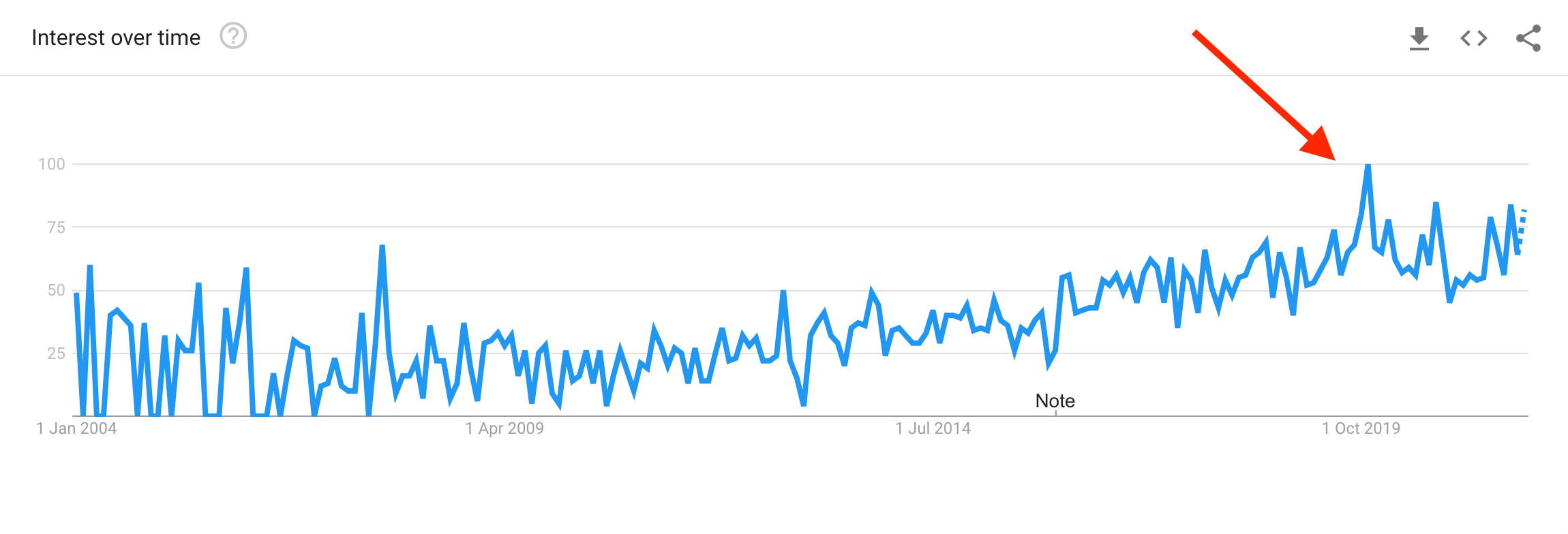 Image Source: Google Trends
Image Source: Google Trends
The reason why demand generation only became popular a few years ago is that it’s often mixed in with other marketing-related activities such as lead generation, or lead gen.
However, considering that acquisition generally becomes more intense and the costs of acquiring a new customer become higher, we’d say that demand generation is a must in every company’s marketing strategy.
To put this in perspective, just consider the fact that, according to a ProfitWell study back in 2018, customer acquisition cost (CAC) is “up nearly 50% over the past five years”.
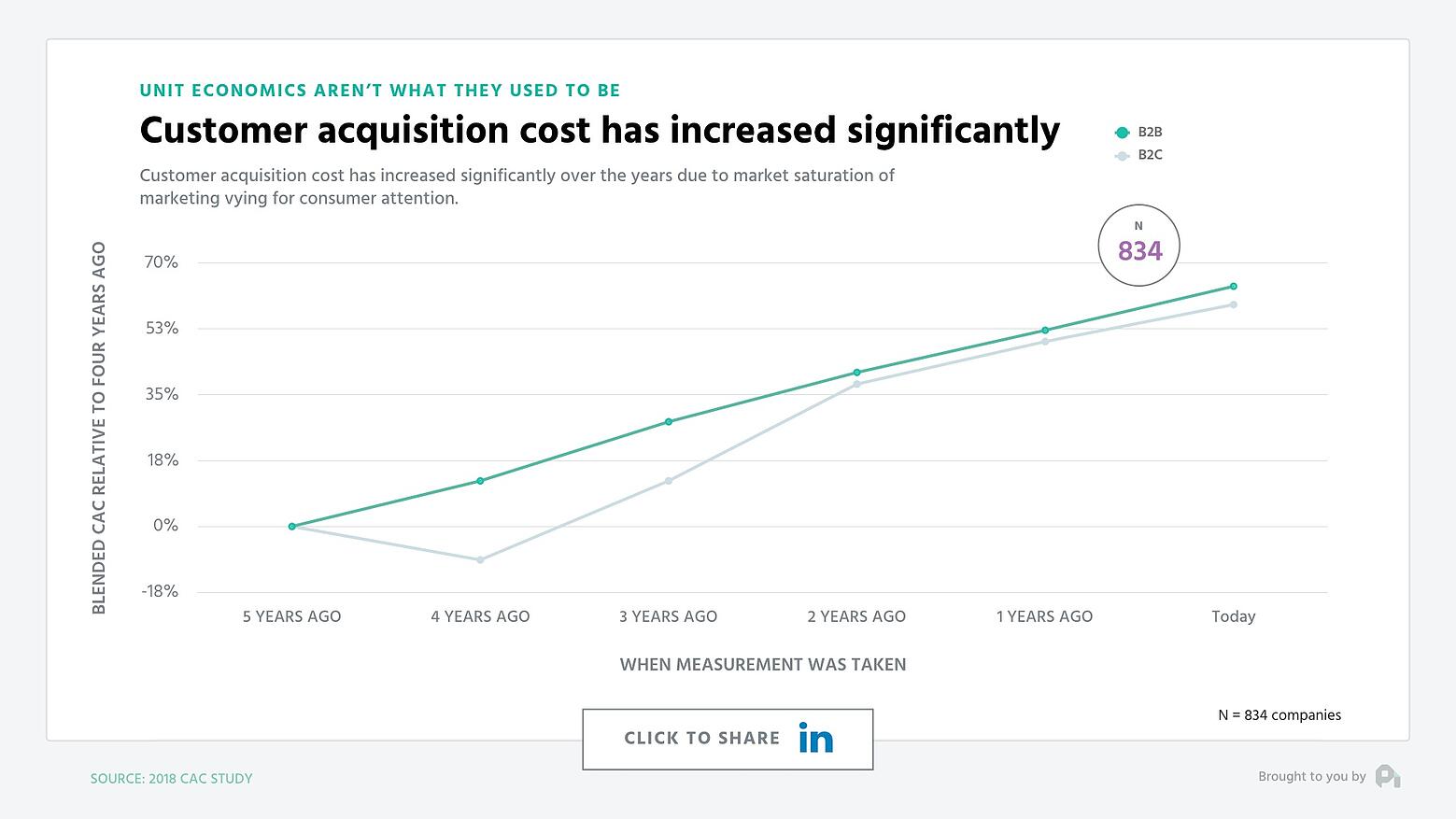 Image Source: ProfitWell
Image Source: ProfitWell
Even though the above data represent the CAC increase for subscription-based software companies (AKA SaaS), we’d assume that something similar is going on in other industries as well.
In that context, the way your business approaches potential customers matters and this makes demand generation even more important.
Let’s dive a bit deeper into the importance of demand generation as part of your marketing strategy.
Why is Demand Generation Important?
By now, you have a basic understanding of what demand generation is.
Still, it’s not completely clear why demand generation is important.
Let’s try to understand the why behind it by presenting three simple benefits.
Benefit #1: Reduced customer acquisition cost (CAC)
As we saw earlier, CAC for SaaS businesses is on the rise.
At the same time, we made the assumption that something similar applies to other industries as well.
The question is: How can a successful demand generation strategy help your business lower its customer acquisition costs?
The answer is pretty simple.
Demand generation — unlike lead generation — focuses on adding real value for your target customers and, although lead volume is usually lower through demand generation, the quality is really high.
This will give you the option to acquire better customers in a much more targeted and specific way, rather than shooting in the dark as many lead generation strategies do.
Author’s Note: Later on in this piece, we’ll present specific examples of great demand gen strategies to help you get a better understanding of how demand generation can contribute to a lower CAC for your business.
Benefit #2: Shortened sales cycles
The second benefit of demand generation is that you have a shortened sales cycle.
This may not be the case as soon as you turn on the demand gen button for your business because things naturally take some time to start working.
However, in general, having a much more targeted approach as to how you go to market will allow you to drastically decrease the time required to close a new customer.
Of course, there are differences between businesses in different industries when it comes to how long their average sales cycle is.
For example, it’s different selling enterprise software to C-suite executives than selling a self-service SaaS with a price point that’s as low as $10 per month.
All in all, successfully executing a demand generation strategy can help you shorten the sales cycle and close new customers faster.
Benefit #3: High-quality leads
It’s evident that one of the benefits of demand gen is the fact that the quality of leads you generate is generally high.
Yes, you may receive fewer leads because you have a much more targeted approach.
The quality of those leads is what really makes a difference.
This better quality then leads to other benefits such as:
- Reducing your CAC
- Shortening your sales cycle
This will get easier to understand once we reach the section with the examples, but for now, just keep in mind that demand generation is the best way for you to get higher-quality leads for your business.
Now that we’ve covered the what and why behind demand generation, let’s move forward with the difference between demand generation and lead generation.
Demand Generation vs Lead Generation: 6 Important Differences
At this point, we’re going to explain the difference between demand generation and lead generation.
Even though both can be part of your marketing efforts as a way to approach different stages of the funnel, generating demand entails adding meaningful touchpoints in different steps of the buyer’s journey, or the customer journey.
A demand generation campaign means you to be way more specific, meaning you optimize the quality of your leads by targeting only people who fit your ideal customer profile (ICP), which is also known as a buyer persona.
According to Chris Walker, CEO at Refine Labs, a demand generation service, the difference between lead generation and demand generation is the following:
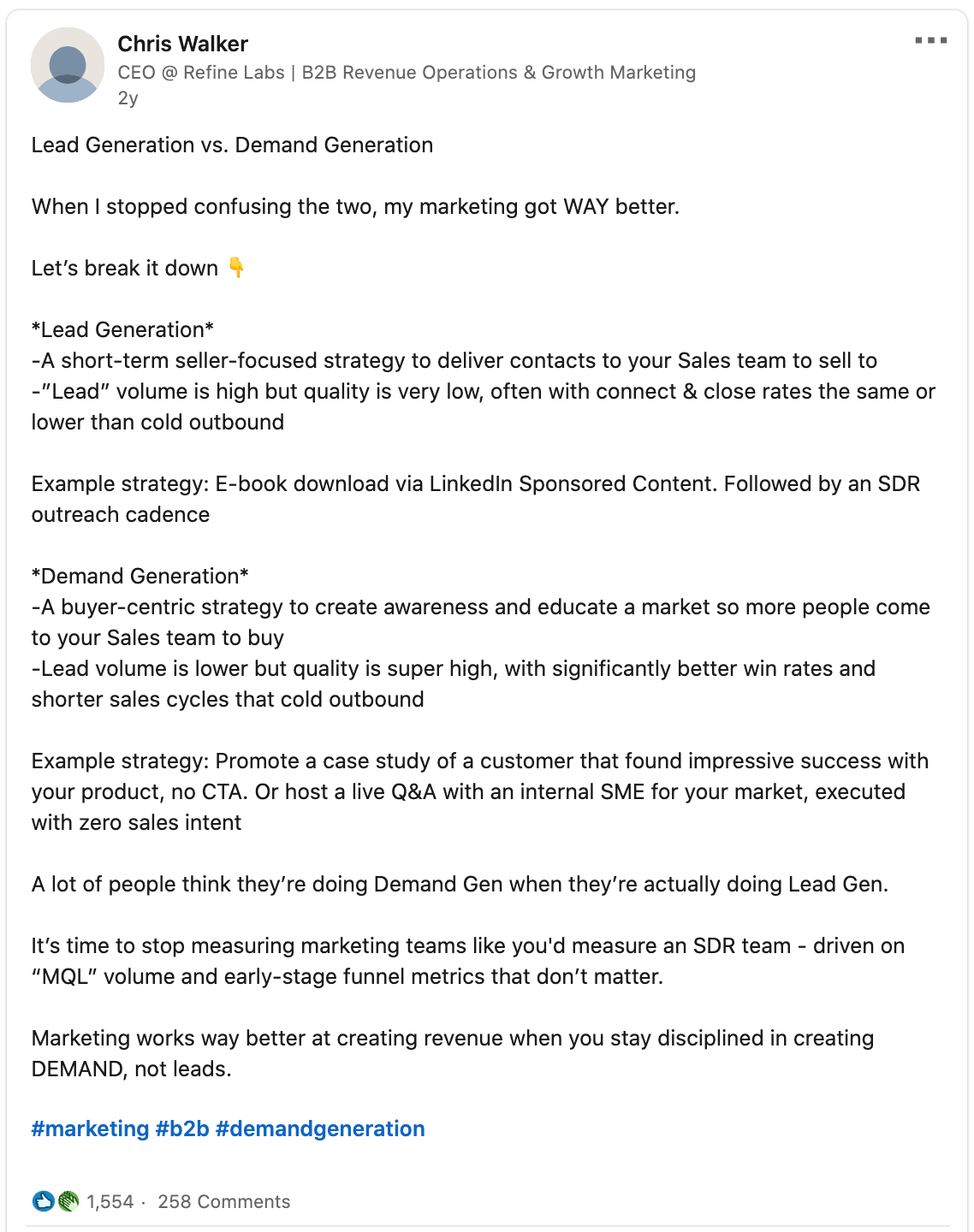 Image Source: LinkedIn
Image Source: LinkedIn
Does this do enough to explain the difference between the two concepts?
It’s maybe a little over-simplified, but for the most part, it’s enough.
The graphic below explains the differences between demand gen and lead gen in more detail.
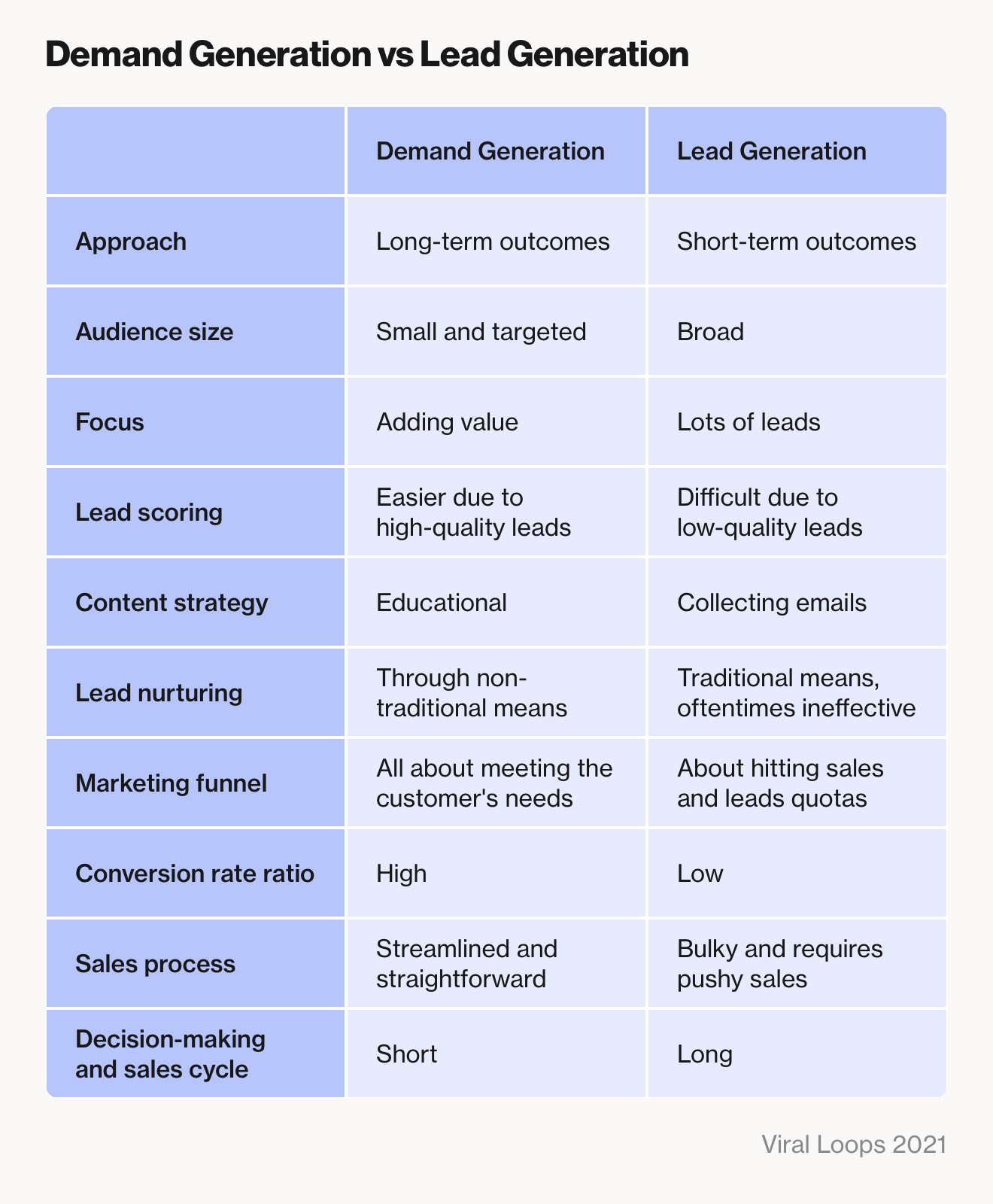
Let’s take a deeper look at each of the two concepts.
Demand generation
The general characteristics of a demand generation program are:
- Approach with long-term outcomes
- Focus on a much smaller audience
- Focus on adding value rather than “closing deals”
- Lead scoring is easier since the quality of leads is higher
- A content strategy focused on educating the prospective customer
- Lead nurturing not done through traditional means, e.g. email campaigns
- A focus on meeting the prospective customer’s needs at every step of the marketing funnel
- Conversion rates and opportunity to close ratios are higher
- A more streamlined and straightforward sales process – no endless follow-ups to close the deal
- Decision-making, and so the average sales cycle, length is shorter
In many cases, you’ll notice that the demand generation tactics that successful companies use are ones that don’t fit the context of conventional marketing.
These tactics are often characterized by critics as “things that don’t scale”, but with demand gen, maybe that’s the whole point.
Let’s take a look at lead generation.
Lead generation
The general characteristics of a lead generation program are:
- Approach with short-term outcomes
- Focus on a wide audience
- Focus on feeding the sales team with leads, regardless of lead quality
- Lead scoring is difficult or impossible due to low-quality leads
- A content strategy focused on collecting emails rather than educating the prospective customer
- Lead nurturing is usually done through traditional means and, in most cases, doesn’t work effectively
- Focus is less on customer needs and more on hitting marketing and sales quotas
- Conversion rates and opportunity to close ratios are lower
- The sales process isn’t streamlined and sales have to “push” really hard to close deals
- Decision-making, and so the average sales cycle length, is slower and less deals close
This isn’t to say that lead generation is the root cause of all problems.
We believe that — especially when it comes to B2B marketing — the way things have been done so far is a bit outdated.
People nowadays want less friction, fluff, and sales pitches and expect much more honesty and value exchange.
In that context, investing in a long-term approach when it comes to your marketing is essential if you want to have a chance of succeeding.
Let’s move on to the next section where we’ll see some of the most important KPIs you need to know about when it comes to your demand generation strategy.
6 Demand Generation KPIs You Need to Know
In this section, we’re going to see some metrics you should know about when it comes to demand generation.
Even though there are many guides out there arguing their point about the most important metrics, in our experience, these are the ones you should be paying attention to.
Metric #1: Number of marketing qualified leads (MQLs) per channel
The number of MQLs, as measured and qualified by your marketing team, is the first metric to know about.
Ensure alignment of the definition of MQLs between your marketing and sales teams.
Metric #2: Number of sales qualified leads (SQLs) per channel
This is the number of SQLs as measured and qualified by your marketing team.
Ensure alignment of the definition of SQLs between your marketing and sales teams.
Also, you need to monitor the conversion rate from MQL to SQL to make sure that your marketing and sales teams are working hand-in-hand.
Metric #3: Close rate per channel
The close rate, sometimes called the closing rate, is the rate at which your SQLs turn into paying customers.
Calculation formula:
Close rate = (deals won) / (number of SQLs) x 100
Metric #4: Best acquisition channel
This may not exactly be a metric, but knowing what your best acquisition channel is can help you make meaningful decisions about where your focus and attention should be.
We recommend measuring your best acquisition channel based on the number of deals won as compared to the total number of SQLs from that channel, rather than the MQL.
This will give you a better understanding of which channel is best at converting.
Author’s Note: If you want to take this a step further, you can try to identify your best acquisition channel by comparing it against metrics like customer lifetime value (LTV), which isn’t easy, but can give you a great insight that you can use to inform your demand generation strategy.
Metric #5: Reason for closing
Once again, it’s not exactly a metric, but it’s extremely important to gather intelligence on the reason why your SQLs close.
Use this to inform your sales process as well as to enhance your marketing messaging.
Metric #6: Reason for not closing
As above, it’s extremely important to know the reasons why your SQLs don’t close.
Is it to do with the initial outlay? Or, maybe the timing wasn’t quite right?
In any case, knowing why your SQLs don’t close can inform your sales process and again go towards enhancing your marketing messaging.
Let’s move forward to the next section, where we’ll see some great examples of demand generation from companies you may have heard of.
6 Demand Generation Examples to Inspire You
At this point, we’re going to check out some examples of demand generation by companies operating in different industries.
Hopefully, this will make the process clear and take you a step closer to understanding what demand gen is all about.
Let’s get into it.
Example #1: Clearscope’s webinar series
The first example we have for you comes from Clearscope, a content optimization tool for content and SEO teams.
As you can see below, Clearscope runs a bi-weekly webinar series.
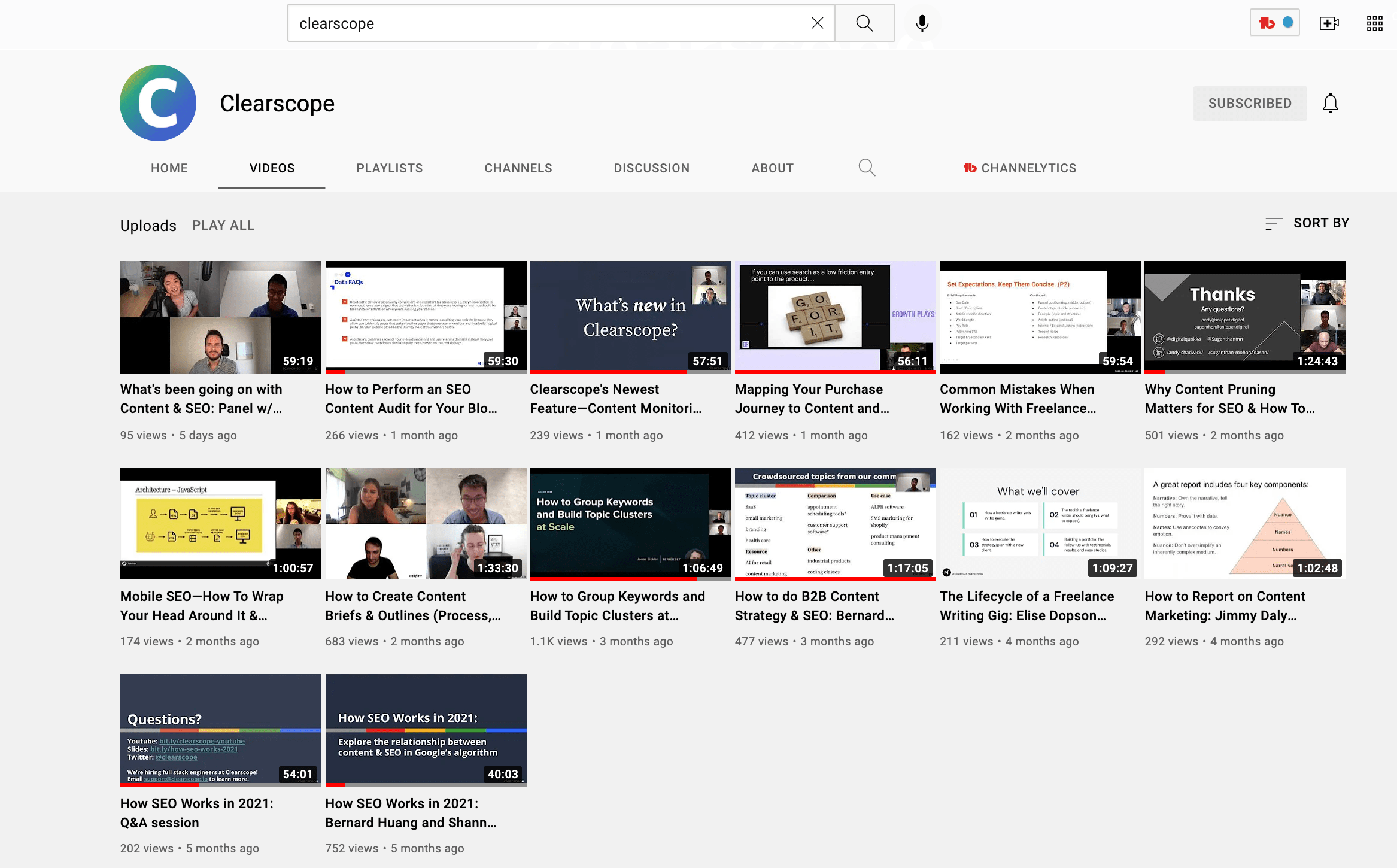 Image Source: YouTube
Image Source: YouTube
Some of the topics that have been covered by Clearscope in these webinars are:
- How to Group Keywords and Build Topic Clusters at Scale
- How to Create Content Briefs & Outlines (Process, Examples, Templates)
- Why Content Pruning Matters for SEO & How To Prune Your Content
- Mapping Your Purchase Journey to Content and Keywords for B2B SaaS
- How to Perform an SEO Content Audit for Your Blog
Not surprisingly, these are all — for the most part — activities that you can perform with Clearscope.
If someone knows how to perform a content audit by watching one of Clearsope’s webinars, there’s a high chance that they’re going to do so by using the tool.
The character of the webinar series is purely educational, though.
There’s no call-to-action (CTA) or offers during these webinars and the focus is solely on adding value for Clearscope’s audience.
You won’t find a sales funnel with landing pages and follow-ups from a sales rep when you engage here.
In this way, Clearscope generates demand for the product and, at the same time, keeps its existing customers engaged by showing them how to get the most out of the product.
Let’s move on to the next example we have for you.
Example #2: Omnisend’s podcast
Next on our list of examples is Omnisend, an email marketing software for ecommerce businesses.
The important word in the above sentence is “ecommerce”; Omnisend has very clear targeting when it comes to its B2B demand generation strategy.
As you can see in the screenshot below, Omnisend has built an extensive library of resources in different content formats for its target audience.
 Image Source: Omnisend
Image Source: Omnisend
One of these resources is the Care Insiders Podcast.
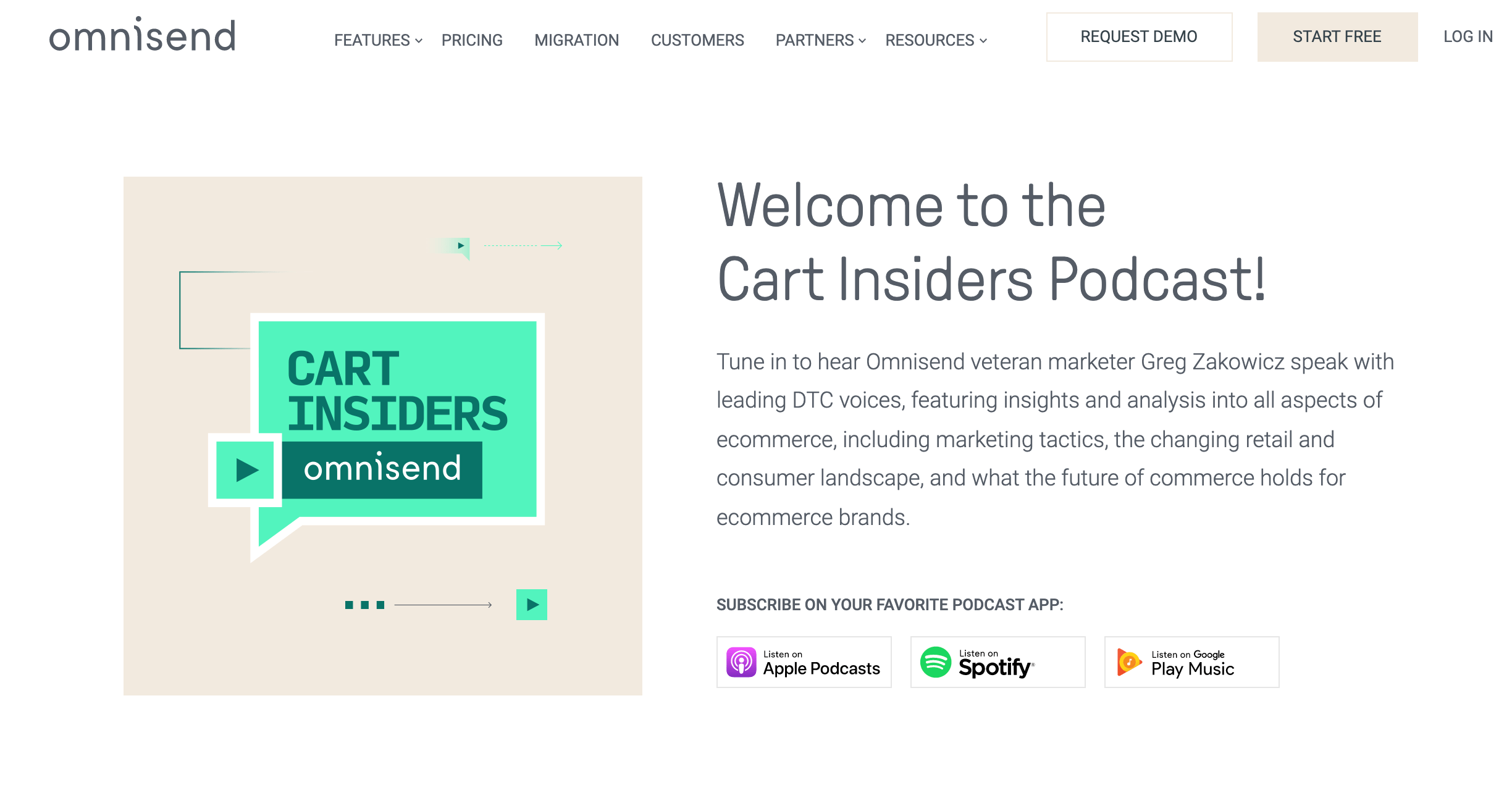 Image Source: Omnisend
Image Source: Omnisend
Taking a look at the episode library, you can see that the content is dedicated to helping ecommerce businesses do better marketing by interviewing ecommerce experts and real practitioners.
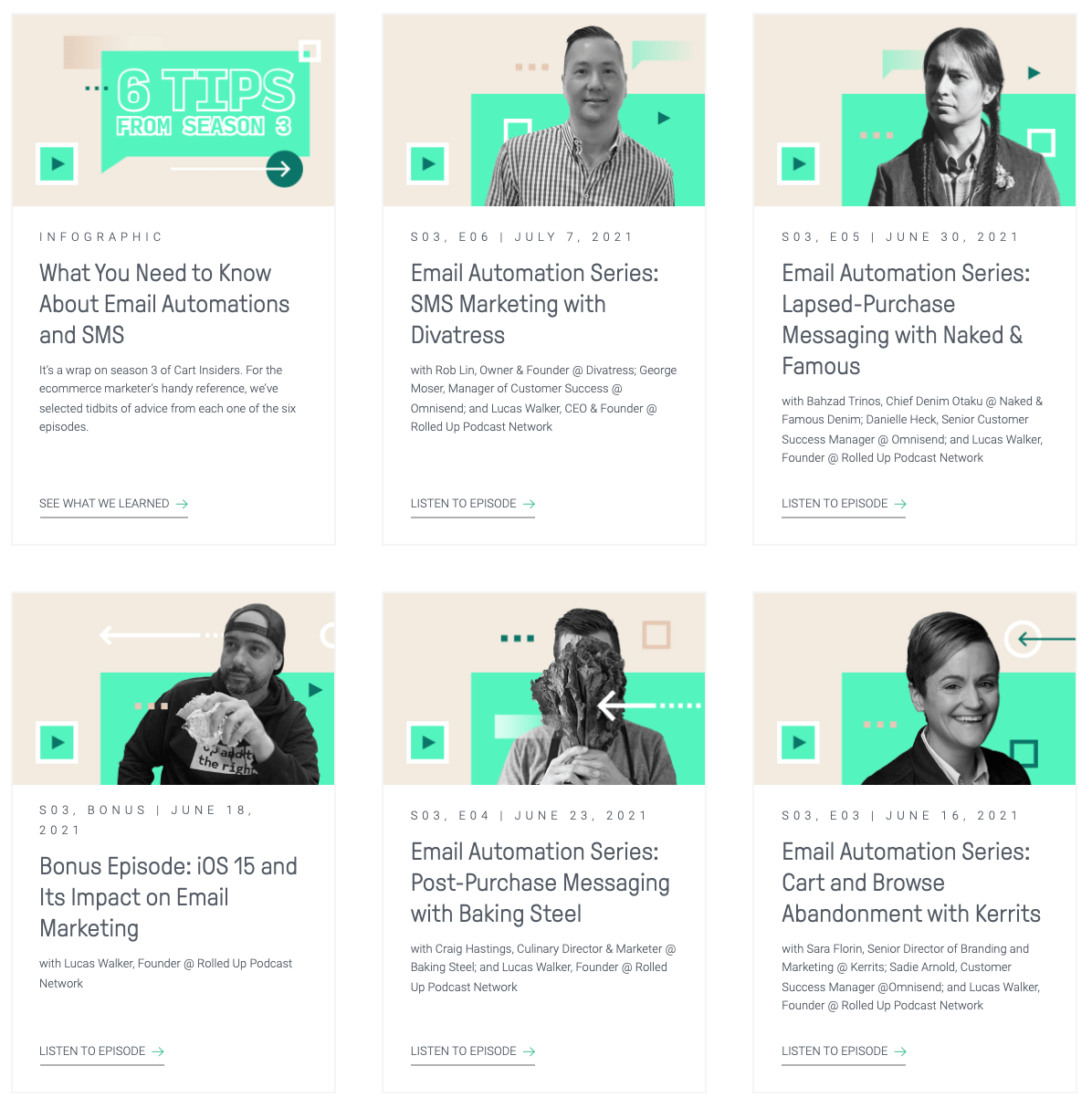 Image Source: Omnisend
Image Source: Omnisend
Once again, there are no sales pitches, no email requests, no lead generation tactics.
It’s based on pure value; anyone can go and listen to any of Omnisend’s episodes.
Of course, creating a podcast is a challenge and so, not many companies are willing to do it.
This is what makes companies like Omnisend so successful, by using it as part of their marketing strategy.
Let’s move on to the next one.
Example #3: Sendoso’s case studies
For those of you who don’t know, Sendoso is the new way to do direct mail marketing.
The company has managed to achieve exponential growth by investing heavily in building relationships with its prospective customers and by educating them about how they can get the most out of its products and services.
Sendoso has a high-frequency publishing schedule for its blog.
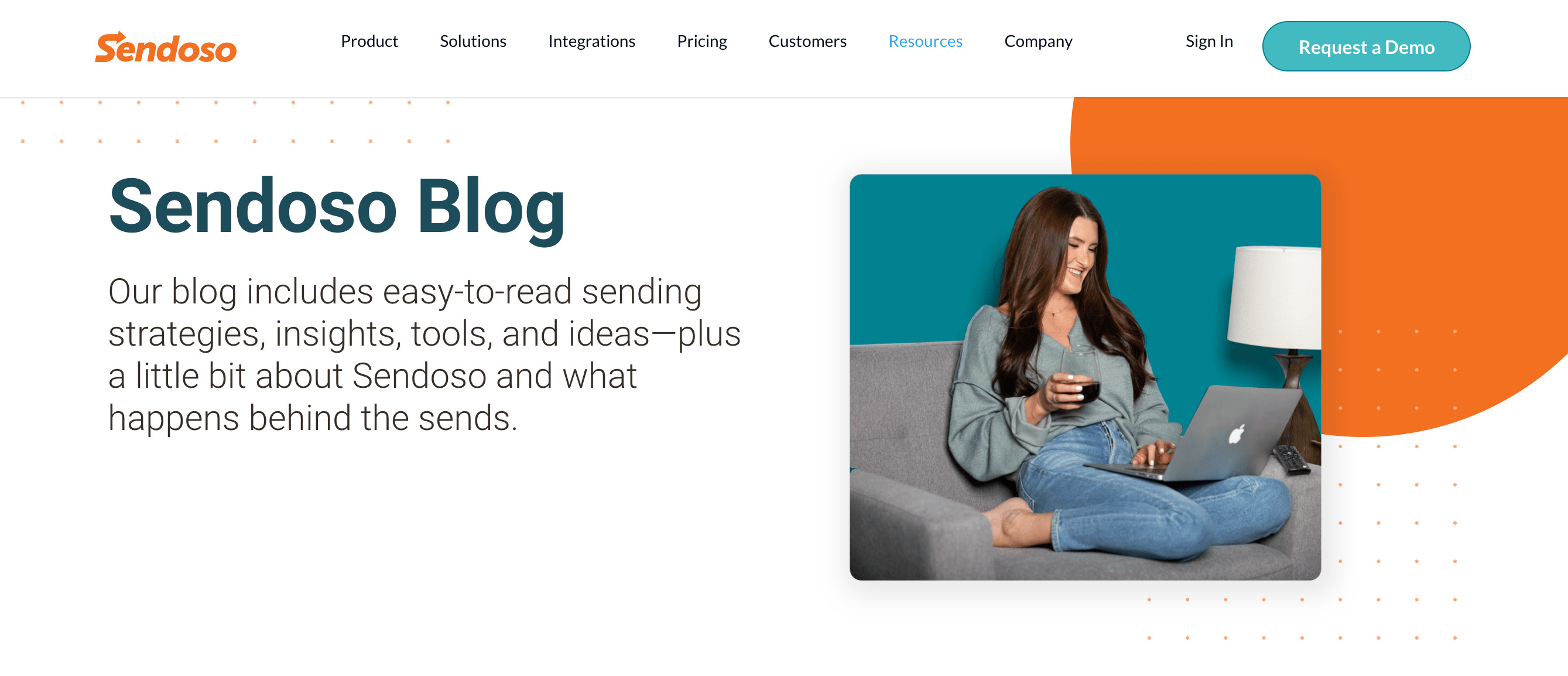 Image Source: Sendoso
Image Source: Sendoso
Part of the content it publishes on its blog is ungated case studies that demonstrate the value of the product to its target audience.
Here’s an example of one of their recent case studies.
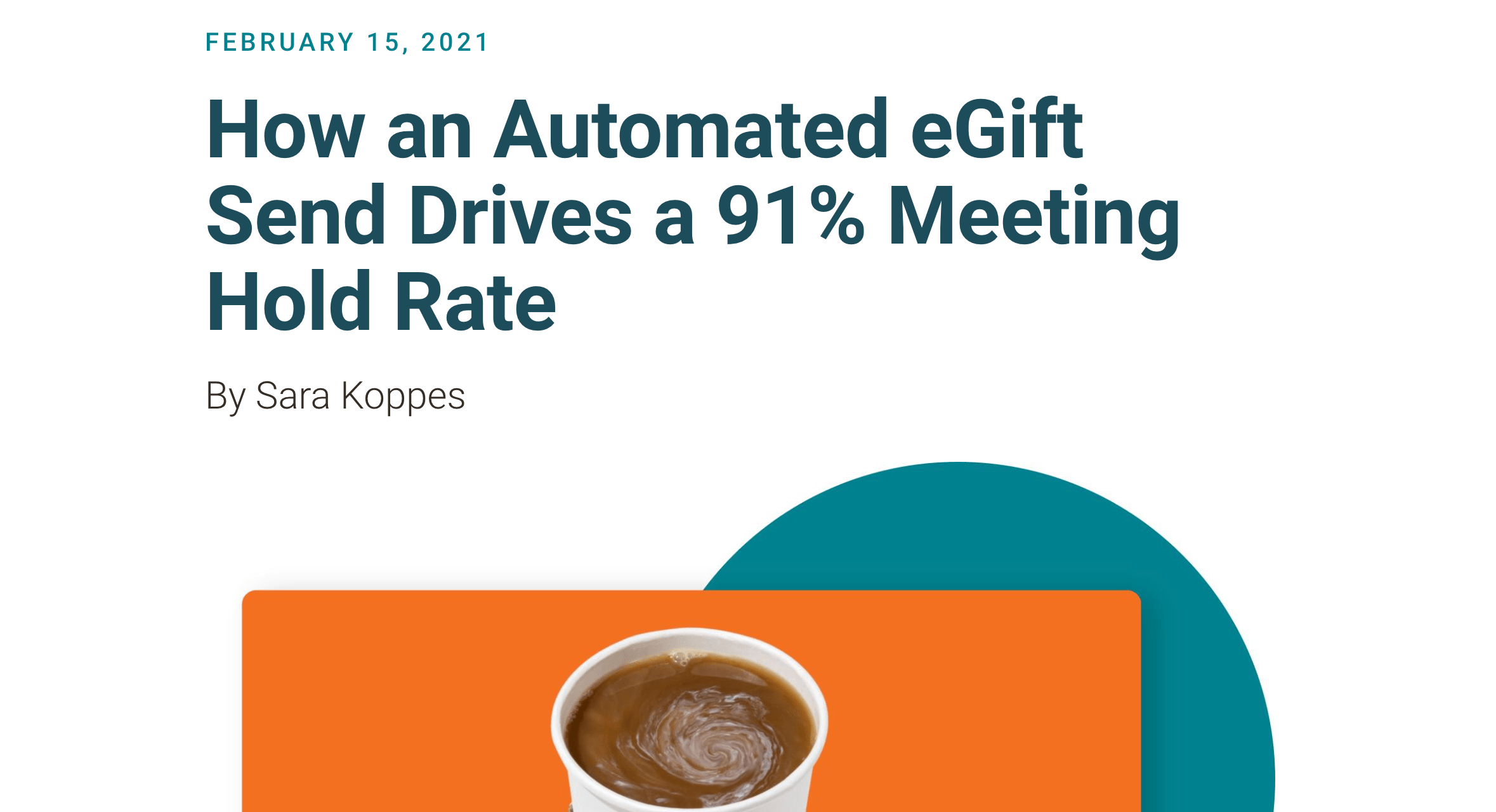 Image Source: Sendoso
Image Source: Sendoso
The case studies include a breakdown of the strategy used as well as the results from using Sendoso.
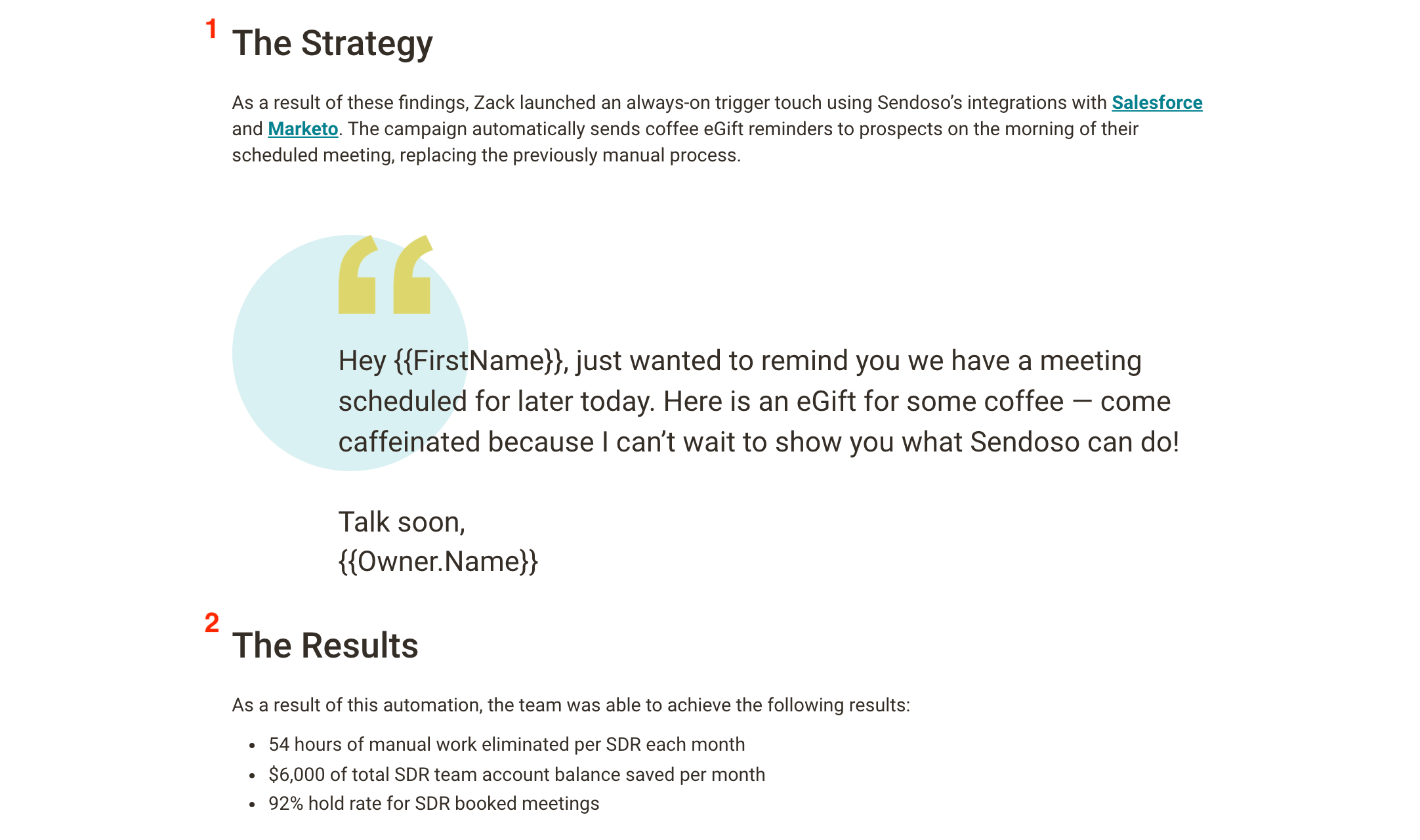 Image Source: Sendoso
Image Source: Sendoso
Like the examples we shared above, the content is free for anyone to see and educate themselves.
There’s no CTA or anything pushing the reader to take an action.
The scope behind this case study is clear.
It’s there to illustrate the value of the product without considering generating leads that’ll later be added to the lead nurturing campaign etc.
That’s the way to approach demand gen.
Well done, Sendoso!
Example #4: ProfitWell’s pricing page teardown
The next example comes from ProfitWell’s pricing page teardowns, one of our favorite ones.
ProfitWell runs the weekly show Pricing Page Teardown, where it breaks down the strategies of popular and up-and-coming SaaS companies.
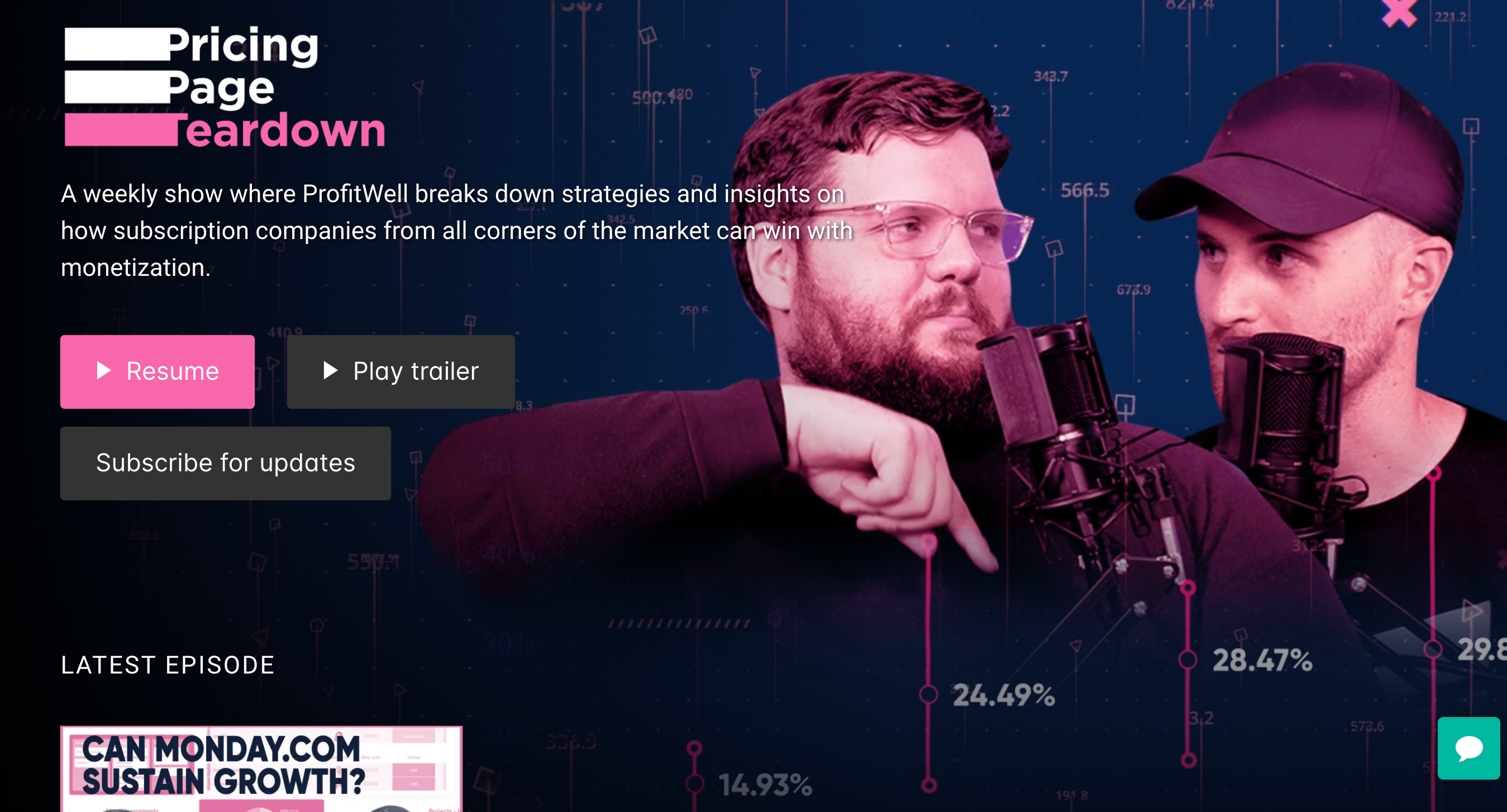 Image Source: ProfitWell
Image Source: ProfitWell
Clicking on any of the episodes, you’ll notice that there’s actually a CTA for those who want to get on a list to be notified for all the new content that ProfitWell publishes, but that’s not necessary and you can skip that step and get right into the content.
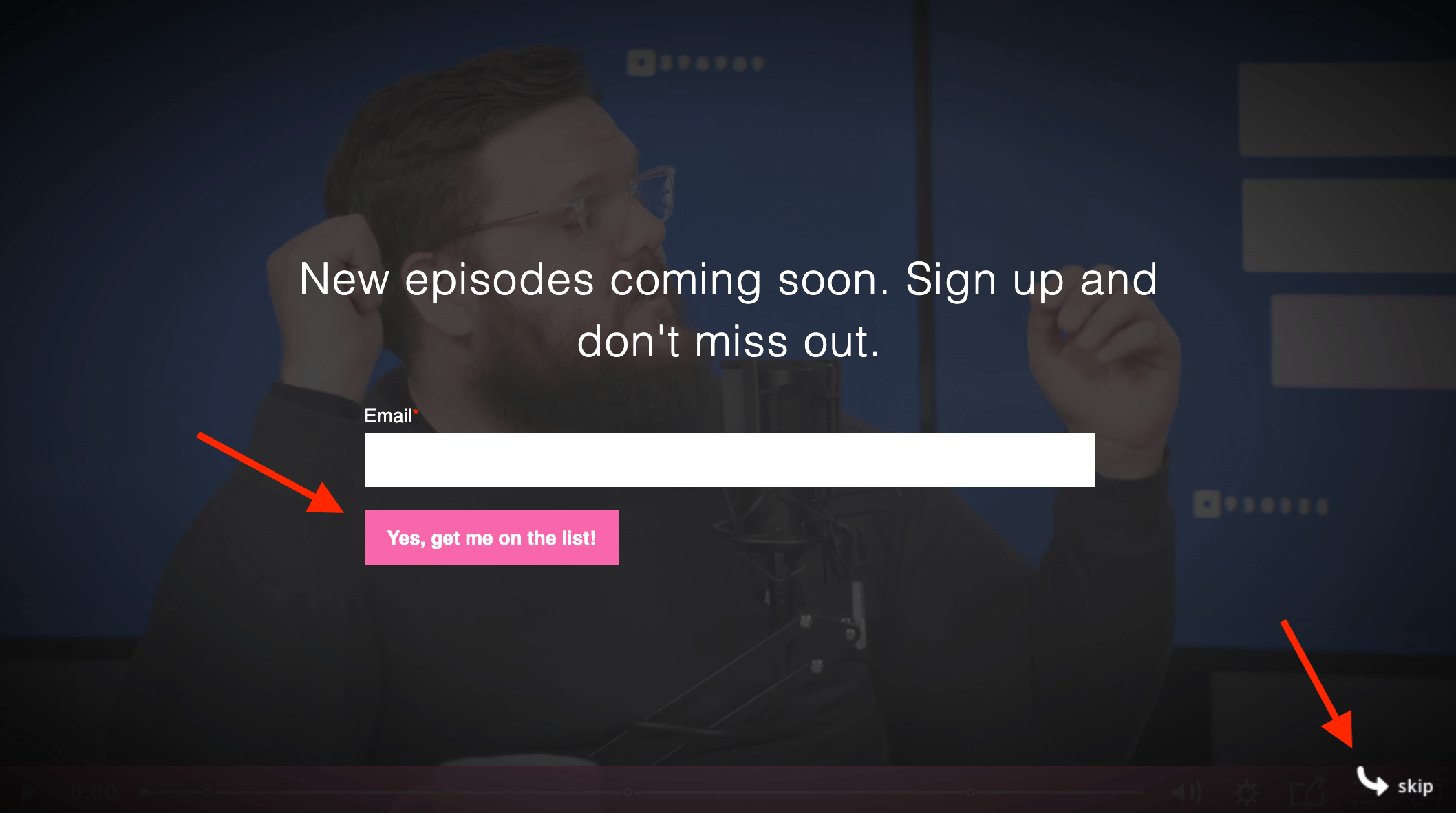 Image Source: ProfitWell
Image Source: ProfitWell
What’s more important is the fact that the content produced by ProfitWell is really high-quality.
Knowing the SaaS industry really well, we can confidently say that you don’t get to see such quality content every day.
Every episode is full of valuable information that’s highly relevant to ProfitWell’s audience and has the sole purpose of educating the viewers and adding value to their business lives.
The team at Profitwell has got it spot on.
Example #5: Lemlist’s email templates
The next example comes from cold email software Lemlist, which we’ve covered a couple of times in the last few posts that we did.
We’re talking about the cold email templates hub that Lemlist has built with the purpose of sharing successful cold email templates for its users.
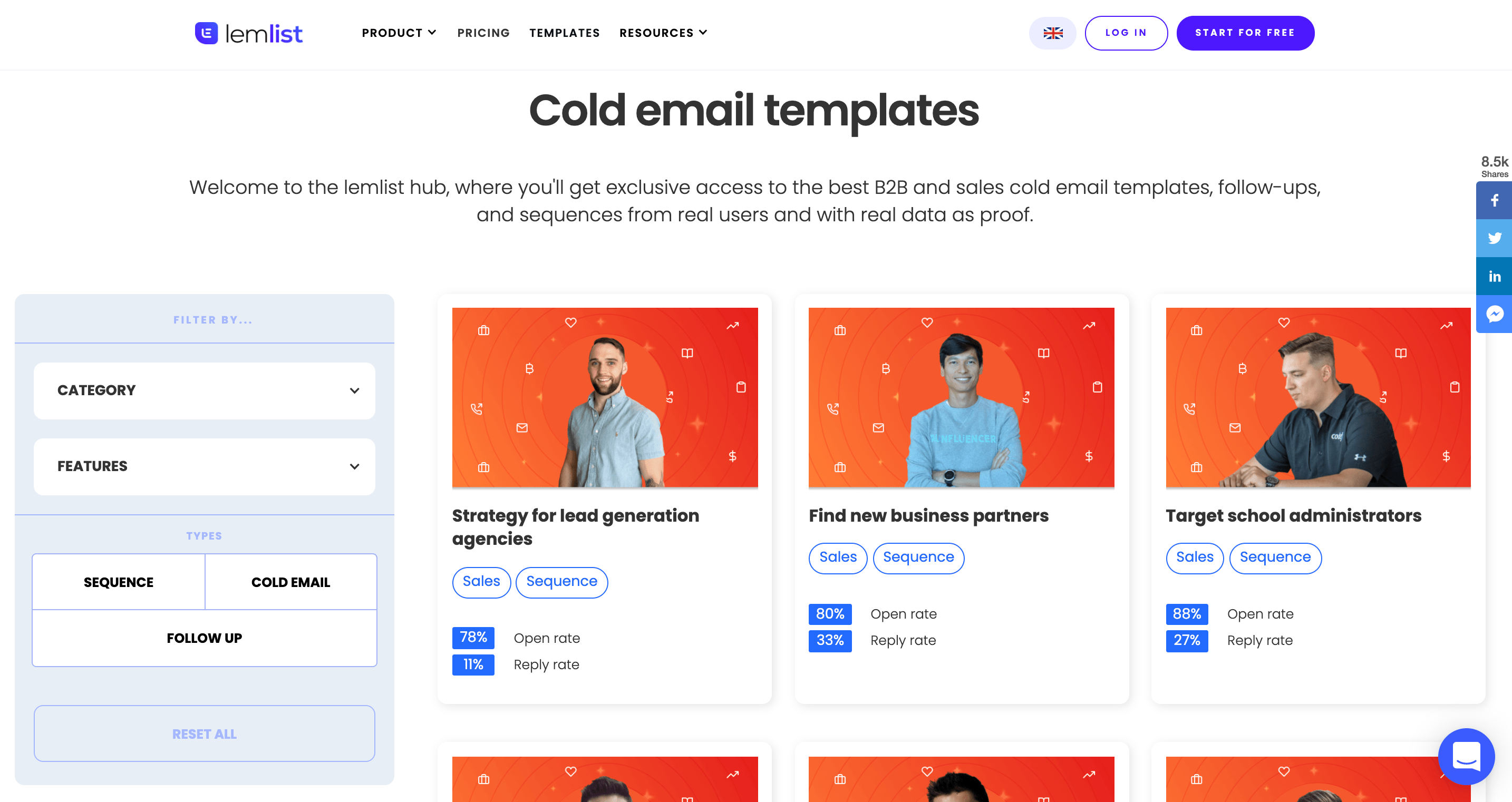 Image Source: Lemlist
Image Source: Lemlist
Instead of creating a gated resource, Lemlist gives away these templates for free to anyone who wants to use them.
As you can see below, for each of these templates, Lemlist offers campaign statistics — since it looks at an actual campaign run by a Lemlist user — as well as the actual email that was sent.
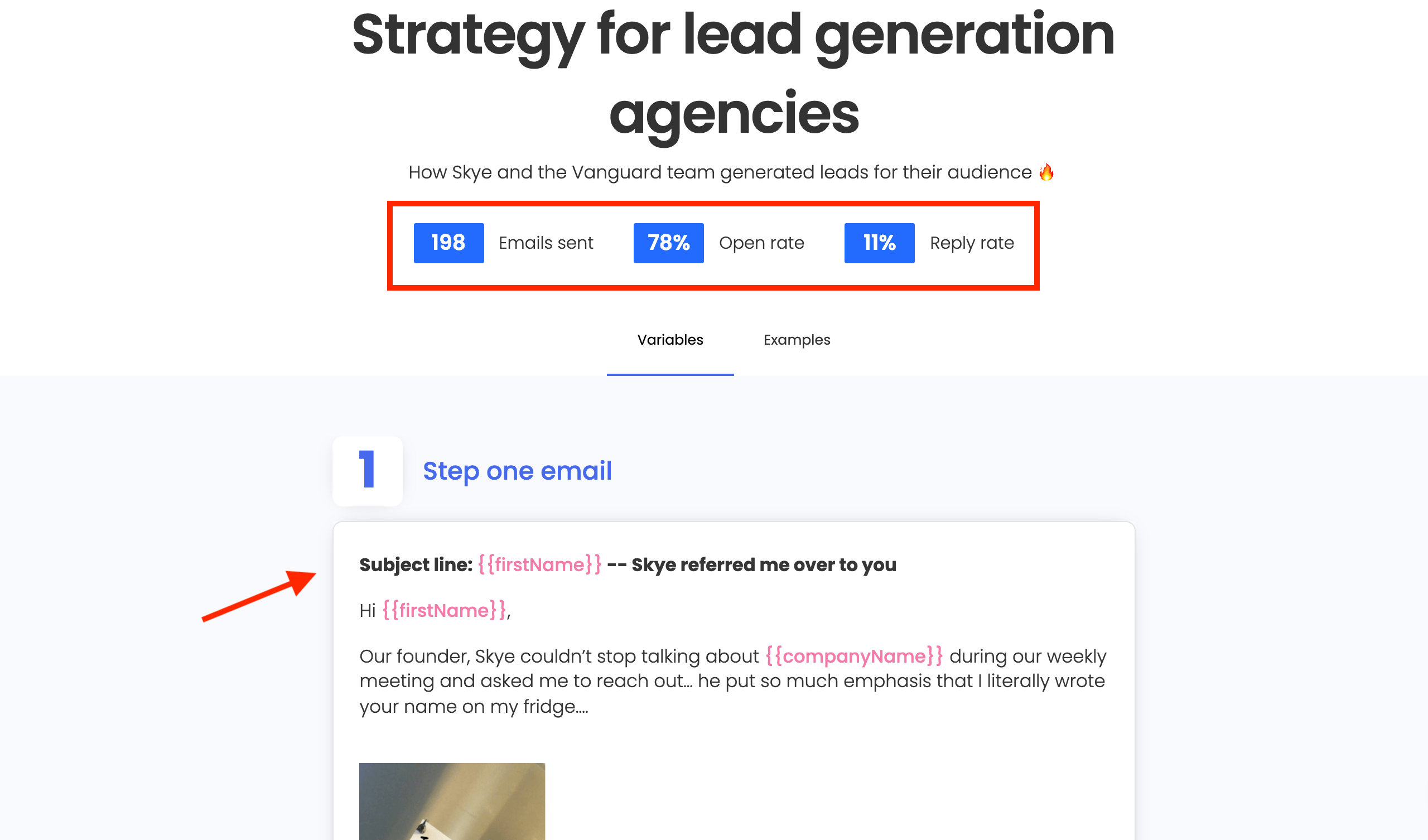 Image Source: Lemlist
Image Source: Lemlist
What’s more, on the main page of the hub, you can use the filtering options to find cold email templates based on your unique situation.
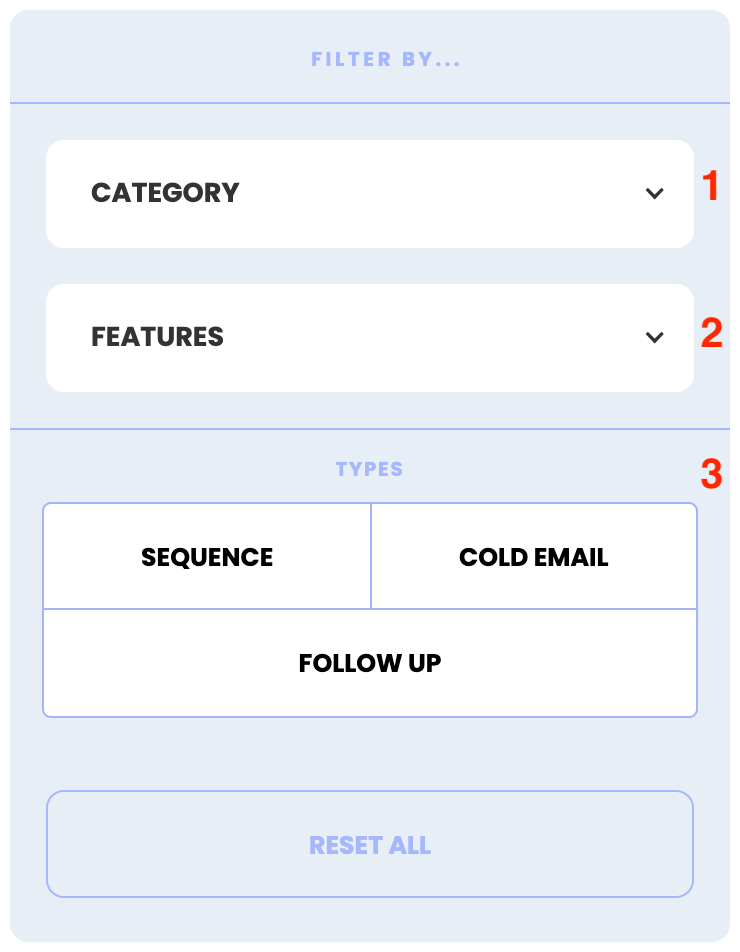 Image Source: Lemlist
Image Source: Lemlist
As you can see above, you can sort results by category, features, and types.
This makes it easy to find what you’re looking for.
What’s important to note here is that, once again, we’re talking about a resource that has the goal of adding value to Lemlist’s target audience without asking for something in return.
If we take this a step further, someone who might be looking for “cold email templates” online, will already be using cold email software to help them with outreach.
This means that people who land at the hub may also be interested in the tool’s capabilities since they specifically want to send a cold email.
Let’s move on to the last example we have for you.
Example #6: SpdLoad’s startup resources
The last example comes from the app development company SpdLoad.
From the company’s website, it’s clear that one of their target customers is startup founders who are interested in building an app or SaaS.
This is why SpdLoad has created resources that are focused on their buyer persona.
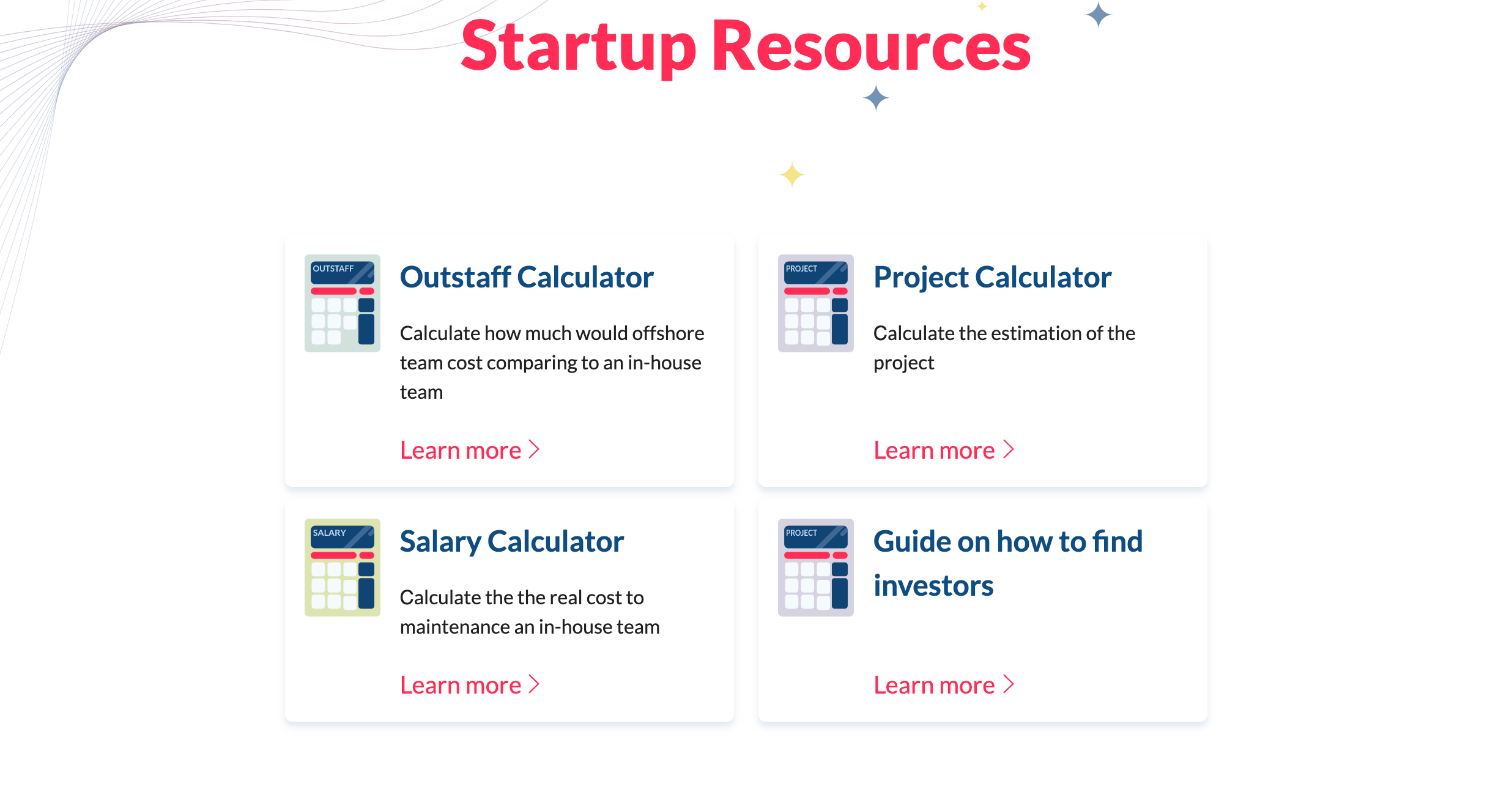 Image Source: SpdLoad
Image Source: SpdLoad
One of those tools is the “Salary Calculator” – see below – which is a very handy calculator for determining the salary expenses of your startup company.
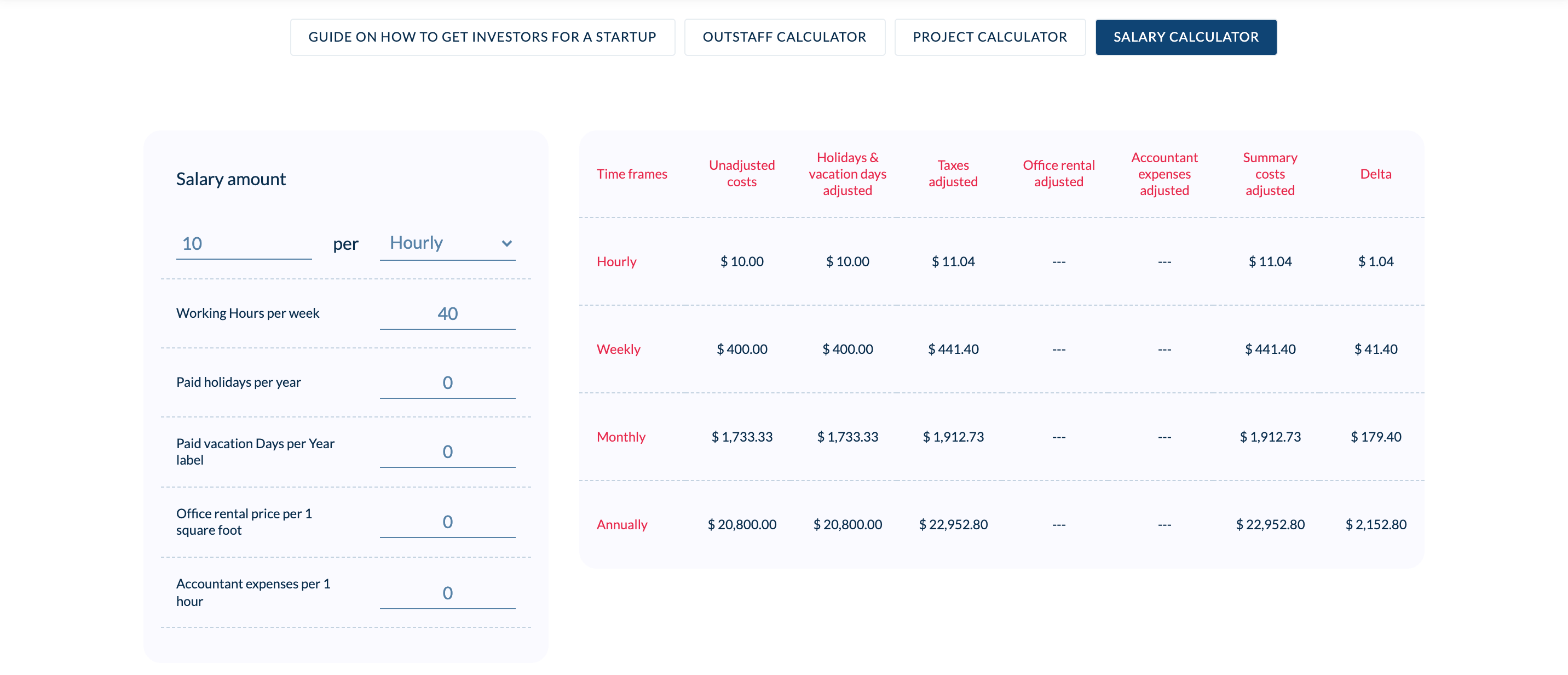 Image Source: SpdLoad
Image Source: SpdLoad
This shows us that SpdLoad really knows what their target customers need and thus the company has created a great resource to cover that need.
There’s no email required to use the tool, which means that every startup founder can go on and find value in it.
This is yet another example of how far you can go when it comes to demand gen – when you know your target market well enough.
Let’s move on to the next section of our guide.
How to Launch a Successful Demand Generation Strategy
Launching a successful demand generation strategy isn’t a one-size-fits-all thing.
Different companies have different needs, different marketing budgets, different limitations as to how they can do marketing, different team structures, competition, and so on.
There’s no one single solution here.
However, if we could fit things inside a framework, we’d say that the following three steps are the ones you should follow when launching a new demand gen strategy.
Step #1: Pick the activities you’re going to invest in
Don’t try to do everything at the same time.
It may feel good to keep your team busy, but results won’t be satisfying enough.
Instead, you should invest time and resources into fewer activities at a time and do them well.
Have you found something that works for you?
Perhaps the new podcast that you’ve launched?
Great, then focus and double-down on that.
Have you found something that doesn’t work for you and seems to be a waste of money and resources?
Great, then stop doing it and focus on other things that do work.
Picking the activities you’re going to invest in and experiment with is the first step of our process.
Step #2: Define your goals and KPIs
You’ve successfully defined the activities you’re going to invest in.
To a certain degree, these activities are going to determine the metrics you’re going to use to measure your success.
Of course, there are going to be some metrics that have to be there regardless of the activities that you’ve picked.
For example, the number of qualified opportunities — whatever that means for you — is going to be there as a KPI no matter what activities you invest time and resources in.
For the most part, though, your selected activities will determine your goals and KPIs.
Step #3: Experiment and iterate based on results
Experimentation is the only way to understand what’s working and what’s not working.
Also, keep in mind that if something’s working for a company in a different industry or even for a company in your industry or a competitor of yours, it doesn’t necessarily mean that it’s going to work for you, too.
You have to try to see for yourself.
Let’s wrap this up and close with some final thoughts.
Before You Go
There you have it.
You now have a good understanding of what demand generation is and how you can integrate it into your marketing strategy.
Remember:
Demand generation is a long-term approach to marketing and results will probably not come right away.
By being consistent with your efforts and by trying to add value instead of just closing deals, you’ll be able to create long-standing relationships with your customers, whom you can then turn into brand advocates.
If you need help in doing so through a referral marketing campaign, feel free to request a demo from us and we’ll see how we can help.
Frequently Asked Questions (FAQs)
Q1. What is B2B demand generation?
B2B demand generation is a series of activities implemented in the context of a B2B marketing strategy or campaign with the goal of generating high-quality and qualified leads for your company through educating your target customers and trying to help them resolve their pain points and problems.
Q2. Is SEO part of demand generation?
Search engine optimization (SEO) can definitely be a part of your demand generation strategy.
Q3. How is demand generation calculated?
Demand generation is calculated through a series of metrics that you need to take into account. These metrics can vary based on what’s important to you and your company as well as the lifecycle stage of your company.
Q4. What is demand generation software?
Even though there isn’t a category of software that could be labeled as strictly “demand generation software”, we’d say that demand generation software is any tool or app that can help you implement a demand generation strategy.
Q5. What is the difference between demand generation and marketing?
Demand generation is — or should be — a part of any successful marketing strategy.
Q6. How is sales involved in demand generation?
Sales should work hand in hand with marketing when executing a demand generation strategy as a way to constantly evaluate the quality of leads generated as well as identify the best channels for demand generation. Sales can also share intel with the marketing team from the sales conversations they have that can be used in the company’s messaging, advertising, etc.
